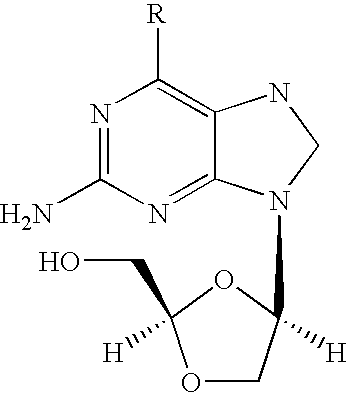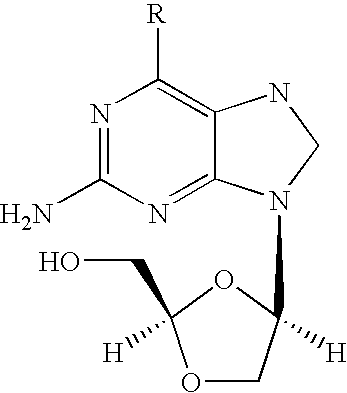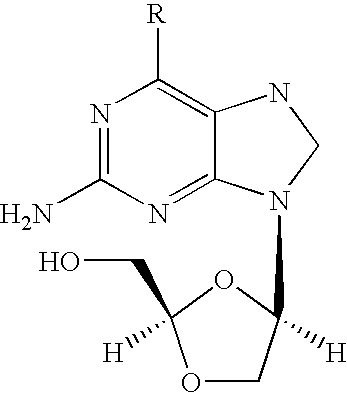Combination therapy to treat hepatitis B virus
a technology of hepatitis b and conjugation therapy, which is applied in the direction of biocide, drug composition, phosphorous compound active ingredients, etc., can solve the problems of fulminant hepatitis, rapid progression, and pain in the abdomen, and achieve the effect of improving the benefit of the patien
- Summary
- Abstract
- Description
- Claims
- Application Information
AI Technical Summary
Benefits of technology
Problems solved by technology
Method used
Image
Examples
example 1
[0053]
Test compounds:DAPD, DXG, (−)-β-FTC, L-FMAUDMVI assay controls:Untreated cells, 3TC (lamivudine),penciclovir (PCV)
[0054]Details of the assay methodology can be found in: Korba and Gerin, Antiviral Res. 19: 55-70 (1992) and Korba, Antiviral Res. 29: 49-52 (1996). The antiviral evaluations were performed on six separate cultures per each of four test concentrations. All wells, in all plates, were seeded at the same density and at the same time.
[0055]Due to the inherent variations in the levels of both intracellular and extracellular HBV DNA, only depressions greater than 3.0-fold for HBV virion DNA from the average levels for these HBV DNA forms in untreated cells are generally considered to be statistically significant [P<0.05] (Korba and Gerin, Antiviral Res. 19: 55-70, 1992). Typical values for extracellular HBV virion DNA in untreated cells range from 80 to 150 pg / ml culture medium (average of approximately 92 pg / ml).
[0056]For reference, the manner in which the hybridization...
example 2
[0074]
Test compounds provided:(−)-β-FTCDMVI assay controls:untreated cells, 3TC (lamivudine),penciclovir (PCV)
[0075]Details of the assay methodology were as given above. Test compounds were received as solid material at room temperature in good package condition. Test compounds were solubilized in 100% tissue culture grade DMSO (Sigma, Corp.) at 100 mM. Daily aliquots of test compounds were made in individual tubes and stored at −20° C.
[0076]TEST COMPOUNDS: Test compound FTC induced significant and selective depressions in extracellular (virion) HBV DNA levels produced by 2.2.15 cells.
[0077]The antiviral activity of FTC was enhanced by co-treatment with PCV. The antiviral activity of the combination therapy was synergistic at all molar ratios tested. As the relative concentration of PCV increased, the cooperative effects of the two agents decreased.
Toxicity Evaluations
[0078]No significant toxicity (greater than 50% depression of the dye uptake levels observed in untreated cells) was...
example 3
Combination Therapy with PMEA
[0080]
Test compounds provided:PMEA, (−)-β-FTC, DAPD, L-FMAUDMVI assay controls:Untreated cells, 3TC (lamivudine)
[0081]Details of the assay methodology were as given above. Test compounds (except for bis-POM-PMEA) were received as powdered material on dry ice in good package condition and stored at −20° C. Test compound bis-POM-PMEA was received as a 100 mM solution in DMSO. Daily aliquots of test compounds were made in individual tubes and stored at −20° C. On each day of treatment, daily aliquots of the test compounds were suspended into culture medium at room temperature, and immediately added to the cell cultures.
[0082]TEST COMPOUNDS (PRIMARY ANALYSES): All of the test compounds induced significant and selective depressions in extracellular (virion) HBV DNA levels produced by 2.215 cells. However, the potencies of test compounds (−)-β-FTC, DAPD and L-FMAU were lower than that observed in earlier analyses. This was most apparent for DAPD and L-FMAU.
[00...
PUM
| Property | Measurement | Unit |
|---|---|---|
| temperature | aaaaa | aaaaa |
| concentration | aaaaa | aaaaa |
| relative molar ratio | aaaaa | aaaaa |
Abstract
Description
Claims
Application Information
 Login to View More
Login to View More - R&D
- Intellectual Property
- Life Sciences
- Materials
- Tech Scout
- Unparalleled Data Quality
- Higher Quality Content
- 60% Fewer Hallucinations
Browse by: Latest US Patents, China's latest patents, Technical Efficacy Thesaurus, Application Domain, Technology Topic, Popular Technical Reports.
© 2025 PatSnap. All rights reserved.Legal|Privacy policy|Modern Slavery Act Transparency Statement|Sitemap|About US| Contact US: help@patsnap.com



